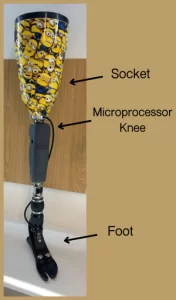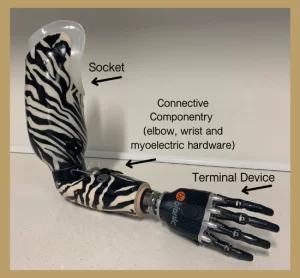Components of Prosthetic Legs – Lower Limb Prosthesis

- Residual Limb – This refers to what remains of your natural limb after an amputation. Some people call this a “stump” though the terminology varies by personal preference. Let your prosthetist know your preferred term.
- Interface – The interface is what acts as a barrier or connection between your stump and your prosthetic leg. Depending on your prescriptions and amputation level, this could be:
– Silicone liner
– Custom pelite liner
– Skin fit (no interface – however its less common today due to advancements in silicone technology)
The interface or liner is the first element that controls your soft tissue and protects the bony areas of your limb from pressures. Factors like tissue consistency, skin condition, suspension requirements, sweat level and your own preference will determine the best interface for you.
- Suspension – This is how the interface (and you!) are connected to the socket. This could be pin/lock, seal, elevated vacuum, self-suspending system.
- Socket – The socket is the hard, outer part of the top of your prosthetic leg, custom-shaped to your residual limb and liner. The prosthetic socket should be designed to further distribute forces, and load soft tissue so you’re not taking weight through parts of your body that can’t tolerate it. Types of sockets include:
– Check sockets ( plastic or 3D-printed for testing the fit)
– Definitive sockets (made with fiberglass, carbon fibre and resin
A well fitting socket ensures comfort and improves mobility.
- Componentry – These are the structural parts that connect the socket to the prosthetic foot. They align the prosthetic leg and limb to ensure proper function.
- Prosthetic Foot – A wide variety of prosthetic feet are available, ranging from functional to recreational. Your prosthetist will work with your preferences and your functional potential alongside your goals to prescribe the right foot for you. ( See recreational prosthetics solutions). Depending on your level of amputation there may be a prosthetic knee or prosthetic hip joint between the socket and prosthetic foot.
- Cosmesis – This is up to you! Carbon finish for a sleek, modern look, pigmented resin, customised with a t-shirt or fabric of your choice, a foam cover, custom 3D printed/laminated cover or realistic silicon skin. The choices are endless, and a way to connect with your artificial limb, and make your prosthetic leg uniquely you. For more on this, check out our Resources.
Components of Prosthetic Arms – Upper Limb Prosthesis
The basic components of Upper Limb Prosthesis are:
- Harness – Main purpose is to act as the control system to provide function for a body powered prosthesis; provides stability and suspension of the prosthesis
- Interface – Acts as a barrier between your skin and the prosthetic socket, such as a silicone liner or sock.. Helps to compress and control soft tissue. With upper limb prosthetics, there is no interface a lot of the time. Skin contact is especially important with a myoelectric prosthesis so the sensors can pick up muscle readings. Advancements in liner technology has enabled sensors to be built into the liner to get the best of both worlds.
- Suspension – How the socket holds on – eg bony lock/self-suspending, vacuum/seal, pin & lock
- Socket – The hard outer shell of the prosthesis that envelopes the residual limb and provides the foundation of the distal componentry. At APC Prosthetics, we specialise in custom socket fabrication for upper limb amputees, ensuring the perfect balance of comfort, mobility, and functionality. Each socket is carefully designed to fit the individual’s unique anatomy, providing support for daily activities and enhancing the prosthetic experience.
- Terminal device – attached to the distal end of the prosthesis to provide function. This may include hands, hooks, other activity specific devices.
- Depending on the level of amputation, you may also include a wrist, elbow andshoulder joint
- Cosmesis – This is up to you! Carbon finish for a sleek, modern look, pigmented resin, customised with a t-shirt or fabric of your choice, custom laminated cover or realistic silicon skin. The choices are endless, and a way to connect with your artificial limb, and make your prosthetic arm uniquely you. For more on this, check out our resource article on specialty prosthesis




